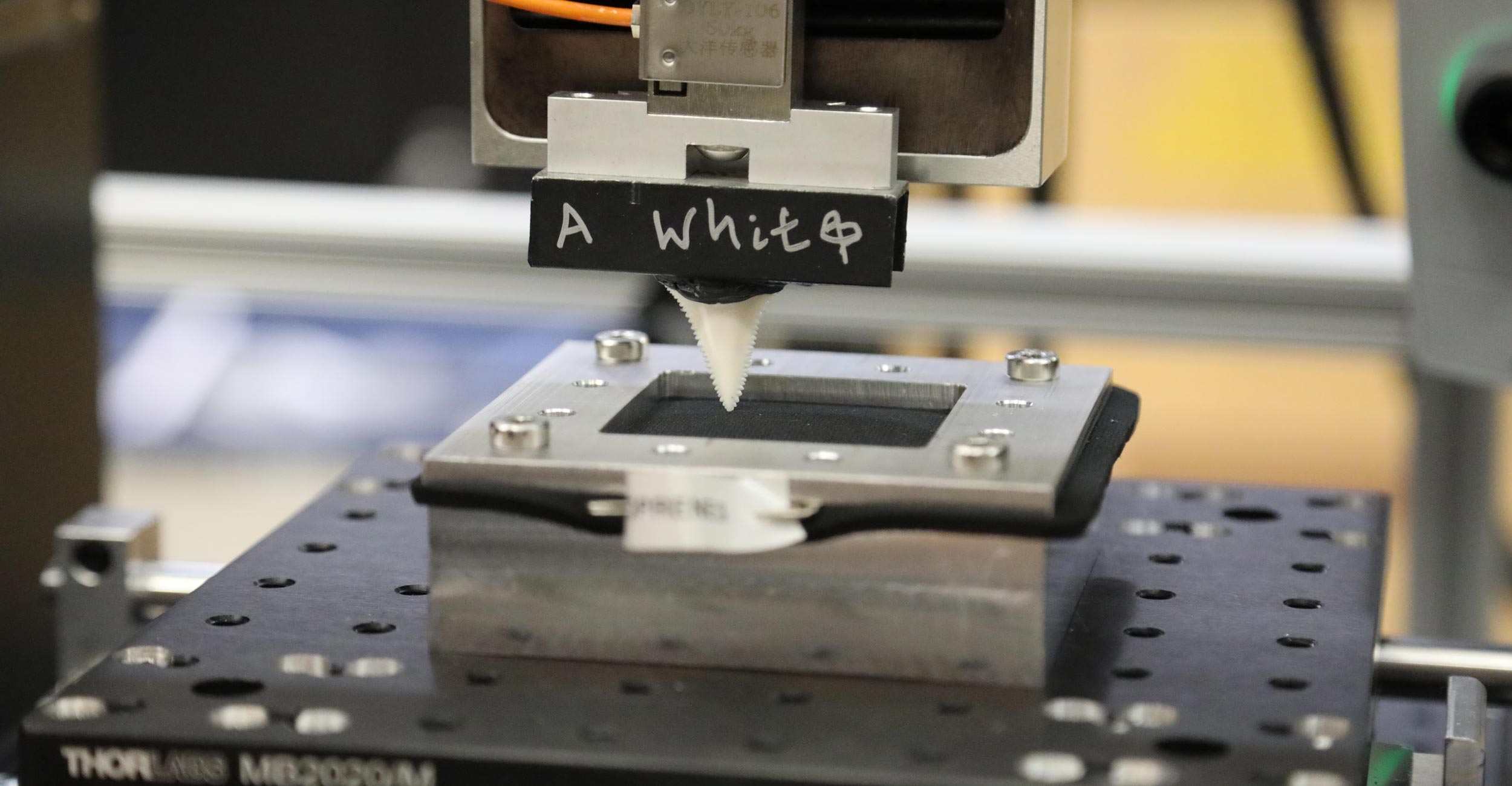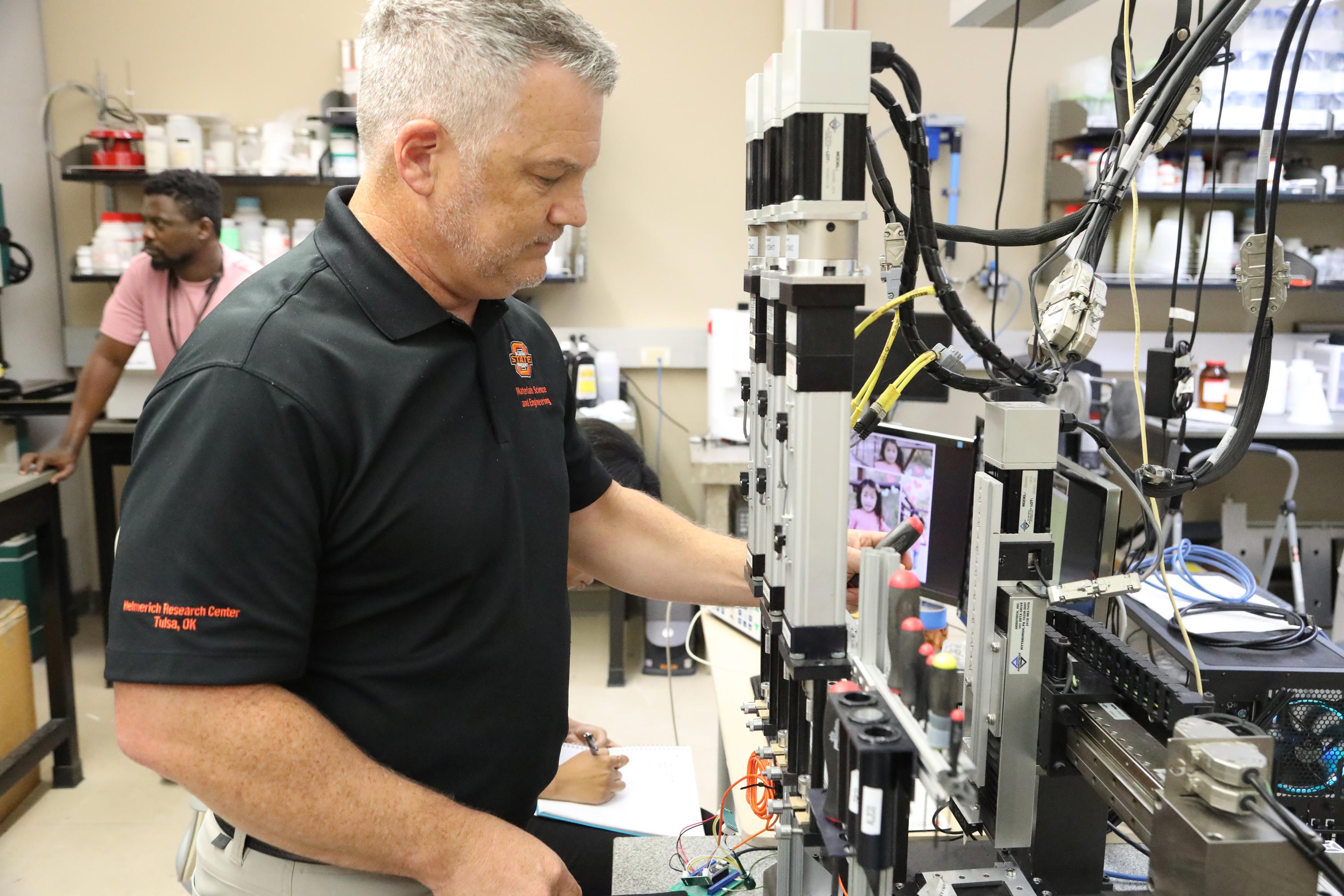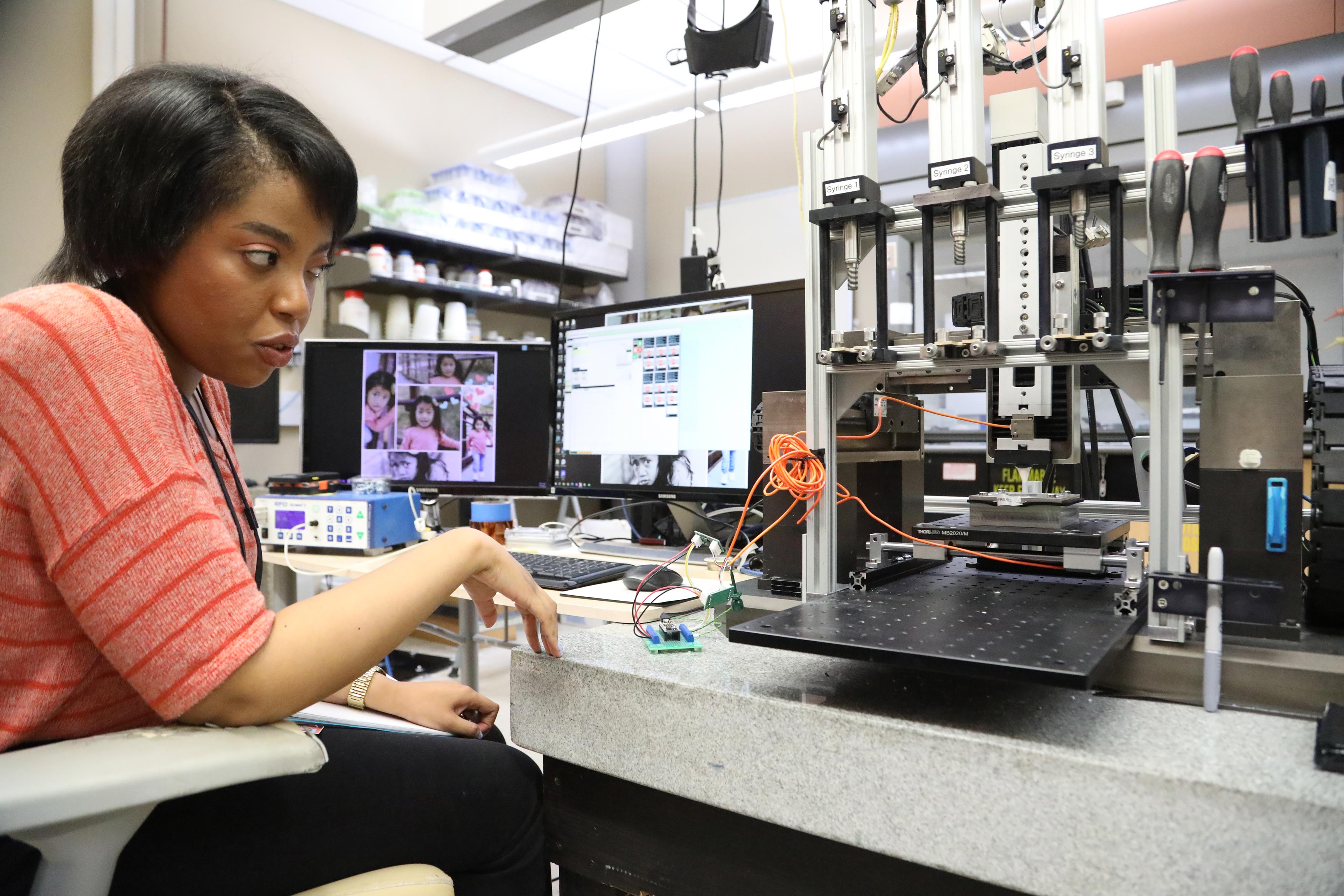
OSU-Tulsa researchers not afraid to test the jaws of sharks
Monday, September 25, 2023
Media Contact: Kristi Wheeler | Manager, CEAT Marketing and Communications | 405-744-5831 | kristi.wheeler@okstate.edu
Oklahoma likely isn’t the first answer if someone were asked where shark bite research is conducted.
However, Dr. Jim Smay, the head of the School of Materials Science and Engineering at Oklahoma State University-Tulsa, is doing just that, with the help of the Oklahoma Aquarium and Ironskinn, a company based in Australia and New Zealand, producing shark bite resistant garments for water sports enthusiasts and commercial divers.
CREATING AN IRON SKIN
Swimming safely with sharks is a problem that is hundreds of years old, however the most recognized and often used shark bite mitigation measure was only devised in the 1960s and ’70s, a chainmail suit worn over a wetsuit.
This medieval invention does help mitigate the effects of shark bites, but is extremely heavy, expensive and cumbersome for the wearer.
As an avid water sports enthusiast, John Sundnes was spearfishing off the coast of California and while surrounded by the remnants of speared fish, he worried the remains might attract sharks. He began thinking how his suit would withstand a shark attack, and wondered if a better solution was available. After searching patent databases, he soon realized that advancements past chainmail were almost non-existent. Thus began the creation of Ironskinn.
“I never thought much about shark bite deterrents or convincing a shark not to bite,” said Sundnes, the executive director of Ironskinn. “Instead, it seemed prudent to study the physics of a shark bite and find a solution to mitigate the damage a shark bite can inflict.”
This approach led Sundnes and his team to begin developing a lighter, more mobile and more cost-effective solution with the help of materials scientists, professional divers and water sports experts.
“When we are in the ocean, we are in the shark’s habitat, not vice versa. Healthy oceans require healthy shark populations and sadly the more bad incidents we have with sharks, the more negative responses we’ll see, like culling or indiscriminate netting practices.”
After tireless research and development, Ironskinn released a high-strength, alloy plated suit that commercial divers could wear and was nearly a quarter of the weight of a chainmail suit while in the ocean, provided more mobility and cost less to produce. This system not only helped mitigate the effects of a shark bite, but offered a safer dive environment if something were to malfunction in their buoyancy compensating devices.
“If you’re diving and something goes wrong with your buoyancy device, a chainmail suit would continue to weigh you down and is difficult to get out of,” Sundnes said. “Our suit is so much lighter that a diver can wear a weight belt and if something goes wrong, they can get rid of the weight belt and make it back to the surface safely.”
The company also developed a soft armor system that uses specific high strength materials in specific configurations. This suit offers the same mitigation solution for shark bites as the armor plate suit but can be created with positive or near neutral buoyancy and can be used in virtually any ocean sport.
RIGHT ENVIRONMENT
During research and development, the Ironskinn team discovered that 64% of shark attacks across the globe can be attributed to three species of sharks, the great white, tiger and bull sharks, according to the International Shark Attack File.
What better way to determine the efficacy of a product than to put it in the jaws of a species most attributed to shark attacks?
However, finding a controlled, replicable environment to conduct testing was no easy task. There are very few aquariums in the world that house any of these three species of sharks.

Oddly enough, the Oklahoma Aquarium in Jenks happens to boast the world’s largest population of bull sharks and is the only such exhibit in the Western Hemisphere. The Oklahoma attraction houses 10 of the “most dangerous sharks known to man,” a moniker granted due to their ability to survive in both fresh and saltwater and they have the strongest bite force of any shark species.
“Our aquarium has a 100,000 gallon, off-exhibit holding space, which allows our staff to raise these sharks from pups to exhibit size,” said John Money, the deputy director of the Oklahoma Aquarium. “Once they have reached an adequate size, we transfer them to our half million-gallon display tank.”
This collection of bull sharks provided the perfect opportunity to test these mitigating garments in a more controlled environment that would be less intrusive to both testers and sharks.
JAWS OF TESTING
The Oklahoma Aquarium would be an ideal environment for testing, however Sundnes and the Ironskinn team wanted verifiable numbers they could use for future development and to help create a standardized criteria for any shark-bite resistant materials.
Coincidentally, the OSU-Tulsa campus is home to the School of Materials Science and Engineering, which is perfectly qualified to provide the expertise necessary to conduct these experiments and procure the data necessary to verify the efficacy of the Ironskinn products.
Smay was tasked with creating experiments that would provide replicable results and prudent data for not only Ironskinn, but the scientific community. The engineering team, consisting primarily of Smay and Ashley Pennyman, a master’s student in materials science, devised an experiment that would secure a piece of feed, in this case salmon, and a mesh sock that contained pressure sensing instrumentation to a plastic board that was then covered with the protective material. This part of the apparatus would be used to document the normal bite forces.
The second part of the apparatus was a boom equipped with steel cable that also had a tension sensor used to document line tension during a bite. The tension force measured would be equivalent to the lateral or tearing forces experienced during the thrashing motion after an initial bite occurs. While there is pre-existing research on the compressive bite forces from sharks, this research appears to be one of the first efforts to measure lateral forces exhibited in shark bites, from violent shaking often exhibited.
“We felt that this setup would adequately document the forces we intended on measuring,” Smay said. “We were measuring upwards of 100 pounds of line tension during a thrashing motion.”
After several trials, Smay determined that while the experiments encouraged a bite, it was hard to accurately determine several variables, namely the number of teeth involved in a bite, and the location in the mouth it occurred. Both variables are key in correlating forces measured with the type of bite.
“No two bites are the same,” Smay said. “These factors are nearly impossible to determine even after post-test inspection. It was this variability that led to the development of a lab test.”
The OSU-Tulsa team began researching, designing and building a one-of-a-kind test apparatus that could mimic the normal forces or bite force, as well as the lateral or tearing forces. The resulting testing apparatus uses a fixed tooth, from any species, that is pushed into a test bed, consisting of a controlled substrate covered by the test material, with an exact amount of force. After the initial downward force is achieved, the apparatus then moves in a sawing motion to replicate the tearing or lateral forces, again with an exact amount of force used.
The development of the in-lab test allows for all variables to be precisely controlled and thus produce data that is easily replicated. While this test was developed with a bull shark in mind, the lab test also allows for the testing of any tooth from any species to better understand differences in bites depending on species.
“We believe that this lab test can provide a standardized test for anyone in this market space,” Smay said. “A standardized test can provide a benchmark for any company that develops shark bite mitigating material to meet.”
PROTECTING THE FUTURE
The future of shark bite resistant materials yields obvious benefits for anyone that works or enjoys the water. However, this research, its findings and the subsequent advancement in safer materials also provides an enormous benefit to shark populations around the globe.
“When we are in the ocean, we are in the shark’s habitat, not vice versa,” Sundnes said. “Healthy oceans require healthy shark populations and sadly the more bad incidents we have with sharks, the more negative responses we’ll see, like culling or indiscriminate netting practices.”

The entire research team approached this challenge with a multipronged goal: mitigate the effects of shark bites for human beings, which would provide a safer environment for sharks as well.
“Dr. Smay’s team at OSU and the Oklahoma Aquarium team, led by John Money, have been nothing short of outstanding to work with,” Sundnes said. “We are very fortunate to work with world class shark experts that know precisely how to work with these animals without harming them in any way, as well as materials scientists that are ideally suited to review materials and bite physics.
“Thanks in large part to these teams, society now has access to garments that can transform our access to ocean sports and activities and are only good news for sharks.”
Photos: Jeff Hopper
Story by: Jeff Hopper | IMPACT Magazine
